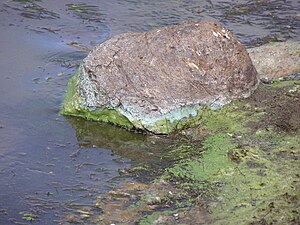
Back سم عصبي Arabic Нейратаксін Byelorussian Невротоксин Bulgarian Neurotoxin Czech Nervengift German Νευροτοξίνη Greek Neurotoxin English Neŭrotoksino Esperanto Neurotoxina Spanish Neurotoxina Basque

Istilah neurotoksin ("racun saraf"; daripada Yunani neuron "saraf" + Latin toxicum "racun") merupakan sejenis serangan kimia eksogen terhadap sistem saraf[3] yang boleh menjejaskan fungsi tisu saraf yang berkembang mahupun matang.[4] Istilah ini juga digunakan untuk menggolongkan sebatian endogen yang boleh meracuni saraf apabila disebatikan secara luar biasa.[3] Biarpun neurotoksin boleh memusnahkan saraf, namun yang penting dalam mengaji sistem saraf adalah keupayaaan neurotoksin untuk menyasar komponen saraf secara khususnya.[5] Antara contoh am neurotoksin adalah plumbum,[6] etanol,[7] glutamat,[8] nitrik oksida (NO),[9] toksin botulinum,[10] toksin tetanus,[11] dan tetrodotoksin.[5]
Kegiatan neurotoksin boleh disifatkan dengan kebolehan untuk menambat kawalan neuron terhadap kepekatan ion di seluruh membran sel[5] atau perhubungan sesama neuron di seluruh sinaps.[12] Patologi pendedahan setempat kepada neurotoksin lazimnya merangkumi ketoksikan rangsangan neuron atau apoptosis[13] bahkan juga kerosakan sel glia.[14] Manifestasi makroskopik pendedahan kepada neurotoksin boleh termasuk kerosakan seluruh sistem saraf pusat seperti kerencatan otak,[4] gangguan ingatan berlarutan,[15] sawan, dan demensia.[16] Selain itu, sering berlakunya kerosakan neurotoksin terhadap sistem sarah periferi seperti neuropati atau miopati. Disarankannya beberapa cara untuk merawat kecederaan akibat neurotoksin seperti suntikan antioksidan,[7] antitoksin[17] dan etanol[18].
- ^ Sivonen K (1999) "Toxins produced by cyanobacteria" Diarkibkan 2013-05-24 di Wayback Machine Vesitalous, 5: 11–18.
- ^ Scottish Government Blue-Green Algae (Cyanobacteria) in Inland Waters: Assessment and Control of Risks to Public Health Retrieved 15 December 2011.
- ^ a b Spencer PS, Schaumburg HH, Ludolph AC (Eds) (2000) Experimental and Clinical Neurotoxicology. Oxford University Press, Oxford, pp. 1310.
- ^ a b Olney, John W. (2002) "New Insights and New Issues in Developmental Neurotoxicology." NeuroToxicology, 23 (6): 659–68.
- ^ a b c Kiernan, Matthew C., Geoffrey K. Isbister, Cindy S.-Y. Lin, David Burke, and Hugh Bostock (2005) "Acute Tetrodotoxin-induced Neurotoxicity after Ingestion of Puffer Fish." Annals of Neurology, 57 (3): 339–48.
- ^ Lidsky, Theodore I. (2003) "Lead Neurotoxicity in Children: Basic Mechanisms and Clinical Correlates." Oxford Journals. Online.
- ^ a b Heaton, Marieta Barrow, J. Jean Mitchell, and Michael Paiva (2000) "Amelioration of Ethanol-Induced Neurotoxicity in the Neonatal Rat Central Nervous System by Antioxidant Therapy." Alcoholism: Clinical and Experimental Research, 24 (4): 512–18.
- ^ Choi, Dennis W (1987) "Ionic Dependence of Glutamate Neurotoxicity." The Journal of Neuroscience, 7 (2): 369–79.
- ^ Zhang, J., V. Dawson, T. Dawson, and S. Snyder (1994) "Nitric Oxide Activation of Poly(ADP-ribose) Synthetase in Neurotoxicity." Science, 263 (5147): 687–89.
- ^ Rosales, Raymond L., Kimiyoshi Arimura, Satoshi Takenaga, and Mitsuhiro Osame (1996) "Extrafusal and Intrafusal Muscle Effects in Experimental Botulinum Toxin-A Injection." Muscle & Nerve, 19 (4): 488–96.
- ^ Simpson, L. L. (1986) "Molecular Pharmacology of Botulinum Toxin and Tetanus Toxin." Annual Review of Pharmacology and Toxicology, 26 (1): 427–53.
- ^ Arnon, Stephen S., Robert Schechter, Thomas V. Inglesby, Donald A. Henderson, John G. Bartlett, Michael S. Ascher, Edward Eitzen, Anne D. Fine, Jerome Hauer, Marcelle Layton, Scott Lillibridge, Michael T. Osterholm, Tara O'Toole, Gerald Parker, Trish M. Perl, Philip K. Russell, David L. Swerdlow, and Kevin Tonat (2001) "Botulinum Toxin as a Biological Weapon." The Journal of the Americal Medical Association, 285
- ^ Dikranian, K (2001) "Apoptosis in the in Vivo Mammalian Forebrain." Neurobiology of Disease, 8 (3): 359–79.
- Dixit A, Dhaked RK, Alam SI, Singh L (2005). "Military potential of biological neurotoxins". Informa Healthcare. 24 (2): 175–207. doi:10.1081/TXR-200057850.CS1 maint: multiple names: authors list (link)
- ^ Deng, Wenbin, and Ronald D. Poretz. "Oligodendroglia in Developmental Neurotoxicity." NeuroToxicology 24.2 (2003): 161–78.
- ^ Jevtovic-Todorovic, Vesna, Richard E. Hartman, Yukitoshi Izumi, Nicholas D. Benshoff, Krikor Dikranian, Charles F. Zorumski, John W. Olney, and David F. Wozniak (2003) "Early Exposure to Common Anesthetic Agents Causes Widespread Neurodegeneration in the Developing Rat Brain and Persistent Learning Deficits." The Journal of Neuroscience, 23 (3): 876–82.
- ^ Nadler, J. Victor, Bruce W. Perry, and Carl W. Cotman (1978) "Intraventricular Kainic Acid Preferentially Destroys Hippocampal Pyramidal Cells." Nature, 271 (5646): 676–77.
- ^ Thyagarajan, B., N. Krivitskaya, J. G. Potian, K. Hognason, C. C. Garcia, and J. J. McArdle (2009) "Capsaicin Protects Mouse Neuromuscular Junctions from the Neuroparalytic Effects of Botulinum Neurotoxin A." Journal of Pharmacology and Experimental Therapeutics, 331 (2): 361–71.
- ^ Takadera, Tsuneo, Risa Suzuki, and Tetsuro Mohri (1990 "Protection by Ethanol of Cortical Neurons from N-methyl-d-aspartate-induced Neurotoxicity Is Associated with Blocking Calcium Influx." Brain Research, 537(1–2): 109–14.